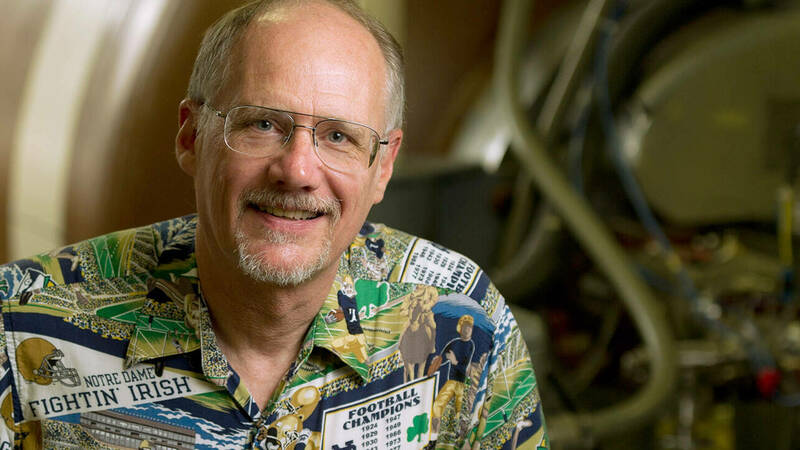
Dave Bartels
Concurrent Professor
- Office
- 203C Radiation Research Building
Notre Dame, IN 46556 - Phone
- +1 574-631-5561
- bartels.5@nd.edu
Research Areas
- Physical/Analytical Chemistry
Research Specialties
- Energy
- Measurement
Prospective Graduate Students
Biography
| Year | Title |
|---|---|
| 2003-present | Notre Dame Radiation Laboratory |
| 1985-2003 | Argonne National Laboratory |
| 1982 | Ph.D., Northwestern University |
| 1977 | B.A., Hope College |
Research Interests
Fast Kinetics of Free Radical Reactions â Free radicals are generated in virtually all radiation-initiated processes, and are responsible for most of the permanent chemical changes. The recombination reactions are often diffusion limited or nearly so, but also depend on pairing of spin to produce stable singlet products. This gives rise to the fascinating Chemically Induced Dynamic Electron Polarization (CIDEP) phenomenon in their time-resolved EPR spectra, and Chemically Induced Dynamic Nuclear Polarization (CIDNP) in NMR spectra of the recombination products, where some lines appear with negative phase due to population inversions.
Radiation Chemistry and Photochemistry of Water â To ionize water molecules in the gas phase requires at least 12.6 eV of energy, but dissociation of water to produce (H+)aq, (e-)aq, and OH radicals can be accomplished in liquid water with 6 eV photons in a photochemical event that is still not well understood. What is the nature of electronically excited liquid water, and how can we explain the escape yields of H atoms, OH radicals, and solvated electrons?
Solvent Effects on Reaction Rates in Supercritical Water â Supercritical water is proposed as the coolant for efficient Generation-IV nuclear reactors, and is the medium for an important advanced oxidation technology for hazardous waste destruction. The properties of water change dramatically in the supercritical region as the water density changes continuously between zero and 1 g/cc. The primary free radicals in water – hydrated electrons, H atoms, and OH radicals – are respectively ionic, hydrophobic, and dipolar, providing opportunity to investigate nearly all possible solvent effects using radiolysis excitation. Many strange effects are being found, such as rate constants that decrease as the temperature is raised.
Selected Publications
- Neupane, P.; Bartels, D. M. and Thompson, W. H. "Exploring the Unusual Reactivity of the Hydrated Electron with CO2" 2024 Journal of Physical Chemistry B, 128 (2), pp.567-575. DOI: 10.1021/acs.jpcb.3c06935.
- Conrad, J. K.; Lisouskaya, A.; Mezyk, S. P. and Bartels, D. M. "Kinetics of the Temperature-Dependent EAq- and •OH Radical Reactions with Cr(III) Ions in Aqueous Solutions" 2023 ChemPhysChem, 24 (24), e202300465. DOI: 10.1002/cphc.202300465.
- Guerin, S. J.; Al-Sheikhly, M. I.; Thompson, A. K.; Goodwin, C. S.; Nam, S. and Bartels, D. M. "H2 Generation by the 10B(N,Α)7Li Reaction in High Temperature Water" 2023 Radiation Physics and Chemistry, 212, 111141. DOI: 10.1016/j.radphyschem.2023.111141.
- Neupane, P.; Bartels, D. M. and Thompson, W. H. "Empirically Optimized One-Electron Pseudopotential for the Hydrated Electron: A Proof-of-Concept Study" 2023 Journal of Physical Chemistry B, 127 (33), pp.7361-7371. DOI: 10.1021/acs.jpcb.3c03540.
- Conrad, J. K.; Lisouskaya, A.; Barr, L.; Stuart, C. R. and Bartels, D. M. "High-Temperature Reaction Kinetics of the eaq and HO2· Radicals with Iron(II) Ions in Aqueous Solutions" 2023 Journal of Physical Chemistry A, 127 (27), pp.5683-5688. DOI: 10.1021/acs.jpca.3c02436.
- Neupane, P.; Bartels, D. M. and Thompson, W. H. "Relation between the Hydrated Electron Solvation Structure and its Partial Molar Volume" 2023 Journal of Physical Chemistry B, 127 (26), pp.5941-5947. DOI: 10.1021/acs.jpcb.3c03158.